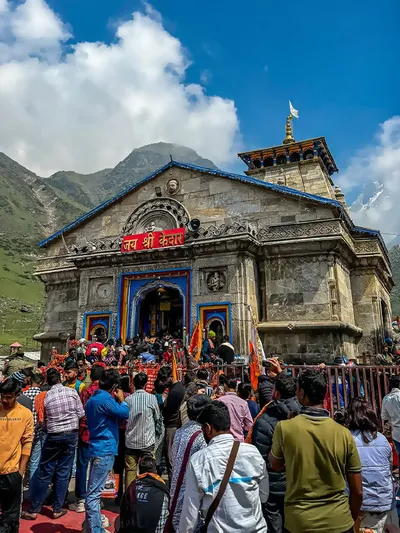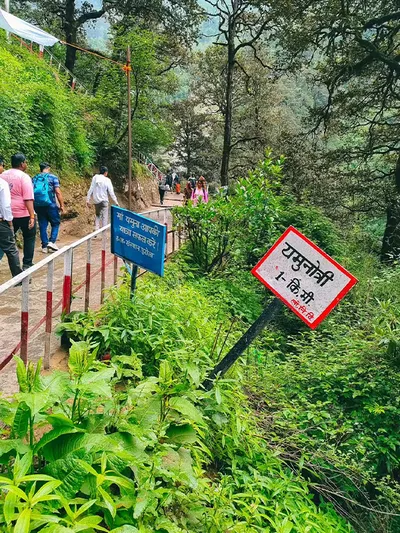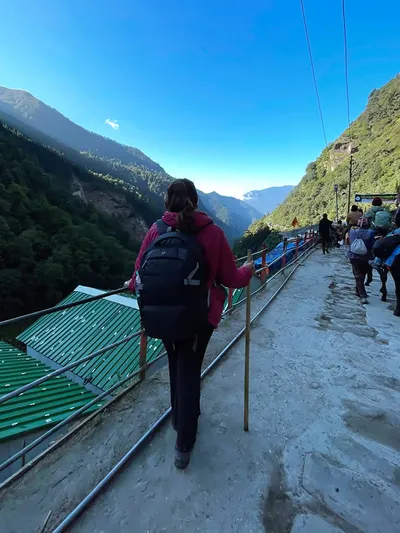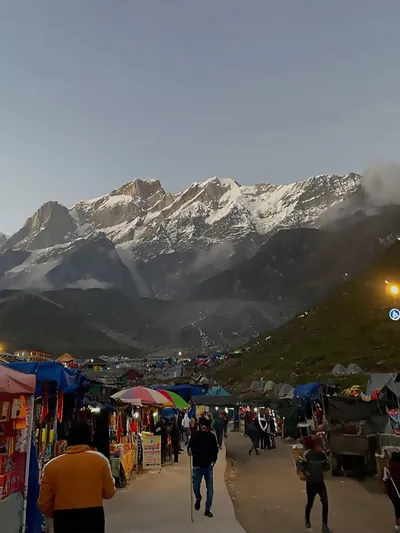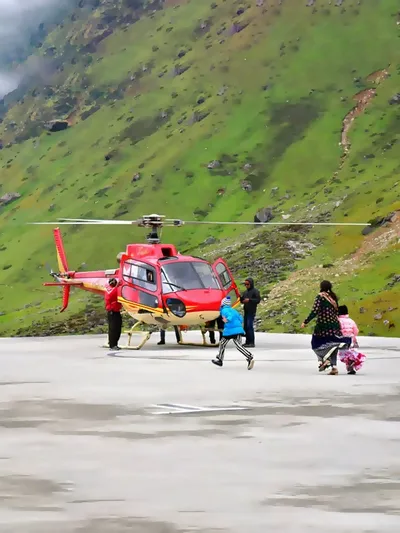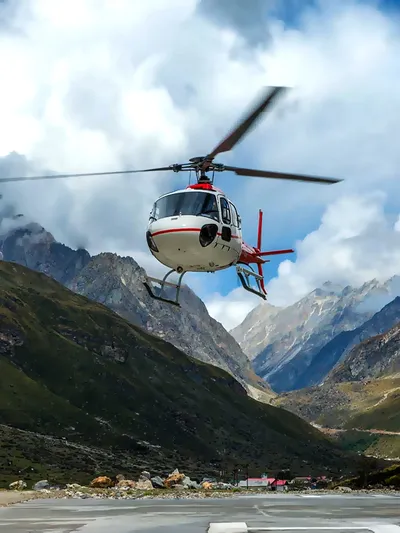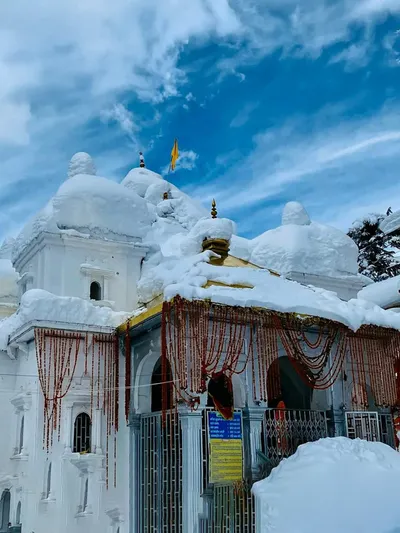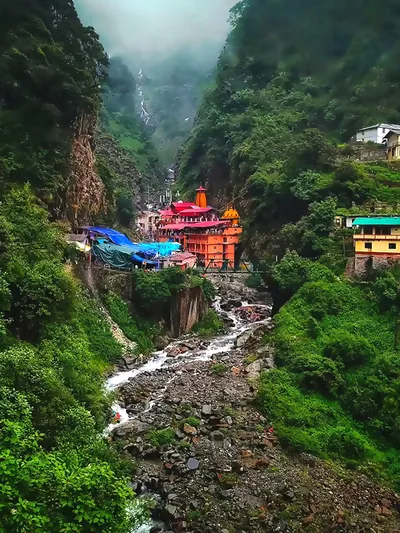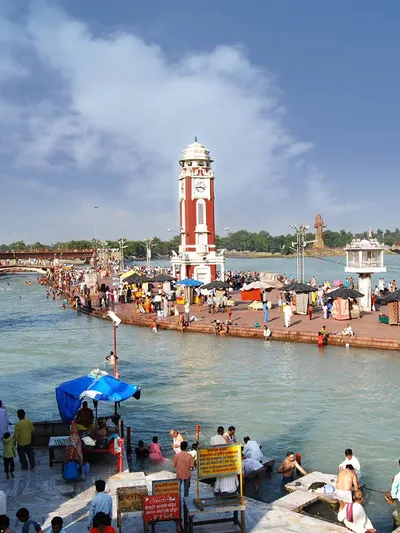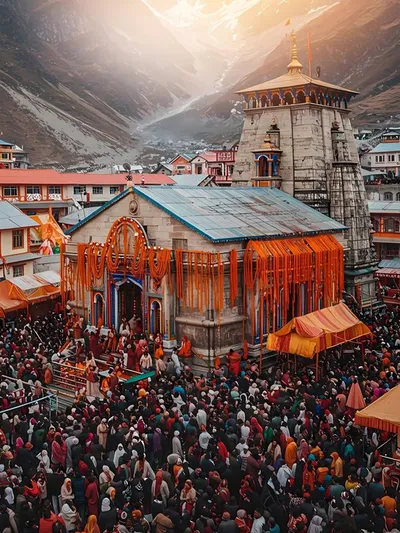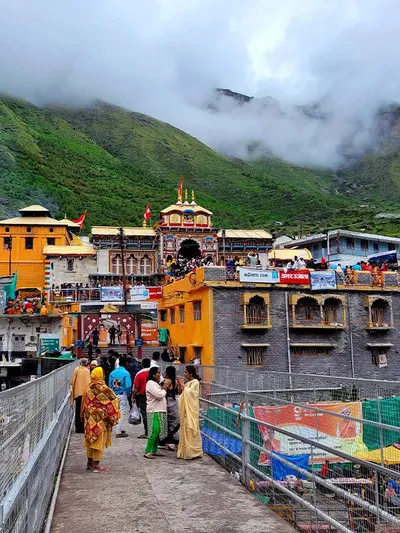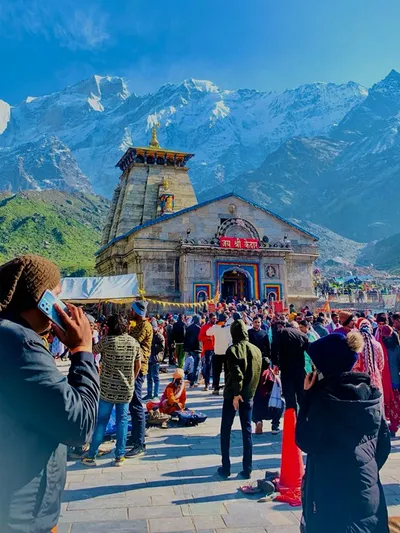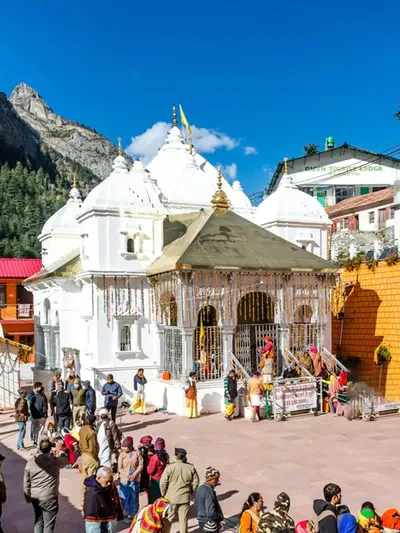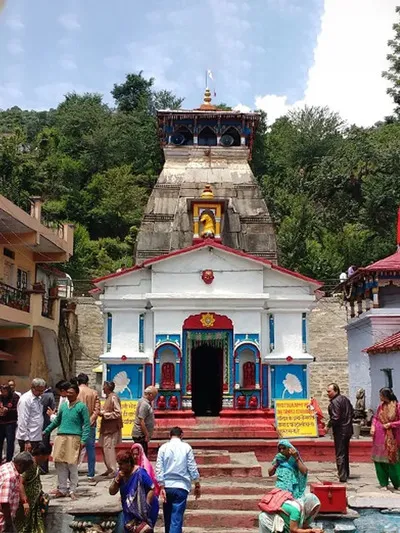Famous Shiva Temples in Garhwal and Kumaon Region of Uttarakhand
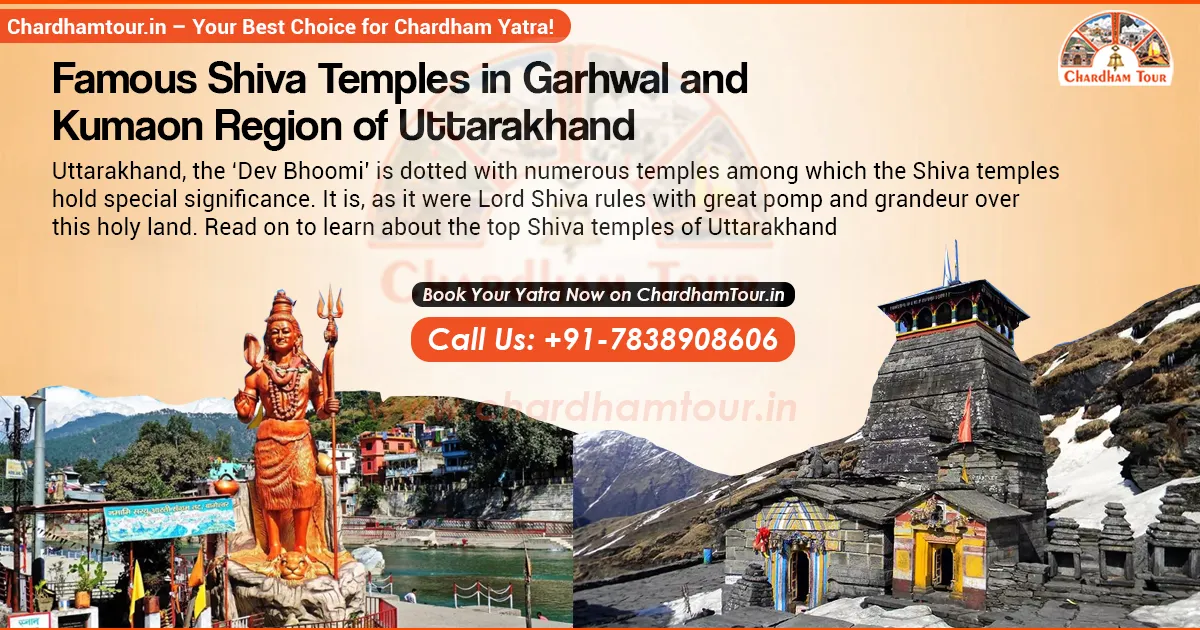
Uttarakhand, the ‘Dev Bhoomi’ is dotted with numerous temples among which the Shiva temples hold special significance. It is, as it were Lord Shiva rules with great pomp and grandeur over this holy land. Read on to learn about the top Shiva temples of Uttarakhand
“Satyam Shivam Sundaram” –He who is Shiva is truth and he is also the beauty incarnate. Lord Shiva, the third of the holy trinity of the Hindus, is the god of destruction. The holy scriptures proclaim that he destructs the creation when it reaches the abyss of decadence. But, there is no feeling of fear or death associated with him. He is the ‘Nataraj’, the cosmic dancer. He is the destroyer of all evil and the protector of the virtuous, the rescuer of the good and the slayer of all things vile and wicked. The benevolent lord ‘Mrityunjay’ can also make his devotee ‘Mrityunjay’, one who has won over death.
A myth relates that Maharishi Markandeya got the blessings of immortality from lord Shiva while he was destined to die at only 16 years. To show their dedication and love, devotees have built temples of their beloved lord to find a place of calm and feel the benediction of their dear lord since time immemorial. We will take a quick view of the Shiva temples in Uttarakhand, the land of gods. The temples are not only spectacular for their architectural grandeur, but in fact more grand for the love and devotion of the devotees that is etched on the rocks for thousands of years fighting the belligerent Time.
There are 13 districts of Uttarakhand in total and each boasts of numerous Shiva temples which have drawn hordes of devotees from near and far. We will present you some very well-known and some less-known temples of Lord Shiva district wise.
Uttarkashi
North of Kashi, here also, like in actual Kashi, Ganga River is Uttar Vahini (that is flows northward as opposite to general flow to south direction). It is similar to Kashi in its renowned ghats, though fewer in number, and also the resident deity, Lord Vishwanath.
Vishwanath Temple
Location–Uttarkashi town.
Built by– Sage Parashurama (renovated by Maharani Khaneti in 1857).
How to Reach– Sri Kashi Vishwanath Temple in Uttarkashi is accessible by bus or taxi from Dehradun (188 km), Rishikesh (170km), Haridwar(190km).
Timings– 6 AM – 7 PM
Entry Fee– Free
Sri Kashi Vishwanath Temple is one of the oldest and most important temples in Uttarkashi, located near the Bhagirathi River. People believe that Maharshi Parshuram built the temple, which was renovated by Maharani Khaneti in 1857. At sunset the sound of the bell, the chanting of Shiva’s hymns and the fragrance of incense create a spiritual calm that helps you feel more connected to the temple’s energy. Visitors can enjoy a stunning view of the Bhagirathi River and surrounding mountains. Many pilgrims visit this temple along with the other Char Dhams.
Kaleshwar Mandir
Location: Joshiyara, Uttarkashi.
Built by: Adi Shankaracharya.
How to Reach: Joshiyara is close to Uttarkashi; you can reach the temple by taxi, auto, or a short walk.
Timings: 7:00 AM – 11:00 AM and 3:00 PM – 6:00 PM.
Entry Fee: Free
Kaleshwar Mandir, dedicated to Lord Shiva, is located in Joshiyara, a small village in Uttarkashi district. It is a very old temple and attracts many devotees during Shivaratri and other religious events. This temple is famous for its beautiful architecture and religious importance. On festivals like Shivaratri, many people from different places visit the temple to pray and take blessings. Many visit the temple to experience its calm vibe and connect with Lord Shiva.
Chamoli District
In Uttarakhand, Chamoli is the second-largest district. It has many holy temples that people visit all year. Chamoli is also famous for the Chipko Movement, where villagers hugged trees to protect them.
Gopinath Temple
Location: Gopeshwar, Chamoli.
Built by: Katyuri kings.
Built In: 12th century.
How to Reach: Buses and taxis on NH7 make it easy to reach Gopeshwar from Rishikesh, Haridwar, and Chamoli.
Timings: 6 AM – 8 PM
Entry Fee: Free
Gopinath Temple is an ancient Hindu temple dedicated to Lord Shiva. People offer only Bel Patra leaves to the Shivling during worship. In old times, It is also believed that a cow used to give milk directly on the Shivling. The temple has a big central dome, which is the main prayer area, also called the sanctum Sanctorum. Inside this area is the Swayambhu Shivling, known as Gopinath, and it is surrounded by 24 doors. In the temple courtyard, you can also see a famous 5-meter-long trident (Trishul) of Lord Shiva. There are several old statues in the temple that are partly broken but still very special.
Rudranath Temple
Location– Chamoli district, Uttarakhand.
Built by– Believed to be built by the Pandavas.
Built In– The exact date is unknown, but it’s an ancient temple.
How to Reach– Reach Gopeshwar by road from Rishikesh/Haridwar, then trek 21 km to Rudranath from Sagar village.
Timings– 6:00 AM to 7:30 PM
Entry Fee– Free
Among all the Panch Kedar temples, this one is the hardest to reach due to the tough route. The idol of Lord Shiva here is covered with a mask that looks strong and serious. The river flowing next to the temple, Rudra Ganges, is also called Baitarani by many. This temple is the fourth stop in the Panch Kedar Yatra, which includes five temples of Lord Shiva in the Garhwal region. It is surrounded by rhododendron trees and green grass fields.
Kalpeshwar Mahadev Temple
Location– Urgam Valley, Chamoli
Built by– Pandavas (as believed)
Built In– The exact date is unknown, but it’s an ancient temple.
How to Reach– From Rishikesh or Haridwar, drive to Joshimath. If coming from Badrinath, return to Joshimath and take the Urgam route.
Timings– 6 AM to 7 PM
Entry Fee– Free
In the Urgam Valley, this ancient temple, part of the Panch Kedars, is said to have been built by the Pandavas. The temple worships Lord Shiva’s hair tied in a knot, therefore it is also called Jateshwar. There’s an old Kalpavriksha tree here, believed to be a wish-granting tree in Hindu mythology. Many people visit this place to pray and also to make wishes under the holy tree.
Rudra Prayag
Along with its beautiful views, this place has several holy spots that attract many visitors looking for peace.
Kedarnath Temple
Location– Kedarnath, Uttarakhand
Built by– The Pandavas (According to legend)
Built In– 8th century (approx.)
How to Reach– From Haridwar, Dehradun, or Rishikesh, drive to Gaurikund. From there, trek 16 km to the temple. Helicopter service is also available.
Timings– 4 AM – 9 PM
Entry Fee– Free
This famous Lord Shiva temple opens for tourists only in the summer. In winter, snow covers the temple, and the idol is taken to Ukhimath for worship. It is known as one of the twelve Jyotirlingas in India. Many people travel to the temple, especially for the Char Dham Yatra. The journey is a memorable one, with beautiful mountain scenery. Pilgrims visit here to pray for good health, success, and peace.
Agasteshwar Mahadev
Location– Agastyamuni, near Rudraprayag.
Built by– Believed to be built by locals in ancient times.
Built In– The exact date is unknown, but it’s an ancient temple.
How to Reach– Agastyamuni is just 18 km from Rudraprayag and can be reached by taxi or bus. It’s around 150–200 km from Rishikesh, Haridwar, and Dehradun.
Timings– 4:00 AM – 9:00 PM
Entry Fee– Free
Agasteshwar Mahadev Temple is a well-known temple for Lord Shiva followers, located 18 km from Rudraprayag near the Mandakini River. This temple is also called Agastyamuni Temple. People believe that Rishi Agastya meditated here for many years. The peaceful and spiritual vibe of this place brings many people here all year. A big fair is held here every year during Baisakhi.
Koteshwar Mahadev Temple
Location– Koteshwar, near Alaknanda River, Uttarakhand.
Built by– Believed to be made by villagers.
Built In– The exact date is unknown, but it’s an ancient temple.
How to Reach– Take a taxi or bus to Rudraprayag from Delhi, Haridwar, Rishikesh, Dehradun, or Kedarnath. From there, the temple is 3 km away by road.
Timings– 6 AM to 5 PM
Entry Fee– Free
Koteshwar Mahadev Temple is an important place of worship for Lord Shiva located close to the Alaknanda River. People believe that Lord Shiva meditated here while traveling to Kedarnath. Many pilgrims visit Koteshwar Temple for blessings from Lord Shiva. There’s an interesting story connected to this temple about Bhasmasur. The legend says that Bhasmasur was given a special power by Lord Shiva, that anyone he touched on the head would turn to ashes. But Bhasmasur wanted to try this power on Lord Shiva himself! Whether you are here for a peaceful spiritual journey or to hear fascinating stories, Koteshwar Temple has something unique for you.
Madhyamaheshwar Temple
Location– 46 km from Rudraprayag, Uttarakhand.
Built by– Believed to be built by the Pandavas.
Built In– The exact date is unknown but it’s an ancient temple.
How to Reach– Take a bus, train or flight to Rishikesh or Dehradun, then drive to Ransi village and trek 16 km to reach Madhyamaheshwar Temple.
Timings– 6 AM to 9 PM
Entry Fee– Free
Located 46 km from Rudraprayag, Madhyamaheshwar is the second temple on the Panch Kedar trek. The peaceful vibe, stunning Himalayan views, and its wonderful architecture make it a favorite for many visitors. The trek to the temple is beautiful, with green fields and fresh mountain air. People visit to pray and enjoy the calm surroundings.
Omkareshwar Temple
Location– Ukhimath, Uttarakhand, India
Built by– Unknown, believed to be an ancient temple
Built In– The exact date is unknown, but it’s an ancient temple.
How to Reach– To reach Ukhimath, the nearest airport is Dehradun (221 km), the nearest railheads are Rishikesh/Haridwar, and you can take a taxi or bus from Rudraprayag (43 km).
Timings– 5:00 AM to 9:00 PM
Entry Fee– Free
Ukhimath is a small town in Uttarakhand, 1317 meters high above sea level. In winter, when Kedarnath and Madhyamaheshwar temples are closed, the idols of gods are brought to Ukhimath. They are worshipped at Omkareshwar Temple. The town is also called Ukhimath. Many people come here in winter to pray when the main temples are covered with snow.
Triyuginarayan Temple
Location– Triyuginarayan, Uttarakhand
Built by– Believed to be built by Adi Shankaracharya.
Built In– The exact date is unknown, but it’s an ancient temple.
How to Reach– Take a train/flight to Haridwar or Rishikesh, then drive 164 km to Rudraprayag (6–7 hours), then 12 km to Sonprayag, and trek 5 km to the temple.
Timings– 6 AM – 8 PM
Entry Fee– Free
Both Lord Vishnu and Lord Shiva are worshiped with great respect here. According to legend, Lord Shiva married Parvati in this place. The holy fire that started during the celestial marriage in Satya Yuga is still burning, and that’s why the temple is called Akhand Dhuni Temple — meaning the temple with the never-ending fire. Pilgrims come here to pray for blessings and feel the spiritual energy all around.
Tungnath Temple
Location– Tungnath, Uttarakhand, India
Built by– Arjuna
Built In– Believed to be built by Adi Shankaracharya.
How to Reach– From Rishikesh/Haridwar: Take a taxi or bus to Rudraprayag, then travel to Chopta, and trek from there.
Timings– 6:00 AM to 7:00 PM
Entry Fee– Free
This temple is part of the Panch Kedar circuit and is the highest temple dedicated to Lord Shiva, located at 3680 meters. Its architecture is similar to other hill temples in the area. It is said that Arjuna, one of the famous Pandavas, built this temple. People visit here for the temple’s spiritual value and its beautiful location in the mountains.
Tehri Garhwal District
Located in the southern Himalayas, this district still has its culture and natural beauty. People believe Lord Brahma meditated here before creating the Universe.
Budha Kedar Temple
Location– Garhwal Himalayas, Uttarakhand, India
Built by– The exact date is unknown, but it’s an ancient temple.
Built In– Unknown, believed to be an ancient temple
How to Reach– Drive or take a bus to Rishikesh or Dehradun, then continue by taxi via Tehri, with a short 10-minute walk to reach Budha Kedar Temple.
Timings– Open 24 hours
Entry Fee– Free
The Shiva Linga here is believed to be the biggest in North India, and the temple is famous for its connection with the Pandavas. Budha Kedar is surrounded by hills with green deodar trees. The area has many small huts and terraced fields where people grow crops, offering visitors a chance to see the life of the local people in the Garhwal Himalayas.
Dehradun
This is the oldest city in India and was once a summer spot for the British. Locals say the name comes from “Dron ki Dera,” which means the home of Dronacharya, the teacher of the Pandavas and Kauravas. According to local stories, Duryodhana made a house of wax here to harm the Pandavas. It’s said that those who visit the temple are freed from bad luck. The temple has several lingas and idols.
Lakha Mandal Temple
It is believed that Duryodhana built a house of lacquer here to burn and kill the Pandavas. Locals believe that whoever visits this temple gets rid of misfortune. The temple houses quite a number of lingas and statues.
Tapkeshwar Temple
Location– Dehradun, Uttarakhand
Built by– Unknown, believed to be an ancient temple
Built In– The exact date is unknown, but it’s an ancient temple.
How to Reach– The temple is easy to reach by road. You can catch a bus or take a taxi from Dehradun. It’s just 5 to 6 km from the main temple.
Timings– 4AM – 10:30PM
Entry Fee– Free
Tapkeshwar Temple is actually a cave where water naturally drips onto the Shiva Linga. This natural dripping, called “Tapak,” gave the temple its name. According to legends, Dronacharya, the teacher of the Pandavas, worshipped Lord Shiva here and stayed nearby. Many people visit Tapkeshwar Mahadev Temple all year to see water drops fall on the Shivling inside Drona Cave. On Shivratri, a big fair is held, and long lines of devotees come for Darshan and enjoy Bhang Prasad.
Rameshwar Temple (Rishikesh)
You can see this colourful temple from far away. It’s close to Ram Jhoola in Rishikesh and is often visited by lots of local devotees.
Pauri Garhwal District
This district has a mix of landscapes. Kotdwar has flat land. As you go higher, you’ll see snowy mountains and green fields. The Ganges river plains and the Himalayan hills make Pauri Garhwal a beautiful place.
Kamleshwar Mahadev Temple
Location– Garhwal region, Uttarakhand, India
Built by– Adi Shankaracharya
Built In– The exact date is unknown, but it’s an ancient temple.
How to Reach– The temple is easy to reach by road from Rishikesh, Haridwar, and Dehradun, with regular buses and shared taxis to Srinagar (Garhwal), which is just 5–6 km from the temple.
Timings– 6:00 AM to 8:00 PM
Entry Fee– Free
Kamleshwar Mahadev Temple is one of the most famous Shiva temples in the Garhwal region. According to Kedarkhand, it is also one of the five Maheshwar Piths in the Himalayas. On Vasant Saptami, 52 different types of dishes are served to the lord. It is believed that if a couple without children holds an earthen lamp all night during Kartik Chaturdashi at the temple, they will have a child.
Neelkanth Mahadev Temple
Location– Near Rishikesh, in Pauri Garhwal district, Uttarakhand.
Built by– Garhwal King
Built In– 17th century.
How to Reach– The temple is 32 km (1–1.5 hrs) from Rishikesh, 75 km (2.5 hrs) from Haridwar, and 60 km (2 hrs) from Dehradun via NH7.
Timings– 5AM – 6PM
Entry Fee– Free
Around 32 km from Rishikesh, this temple is in a beautiful and peaceful place. It is called Veerabhadra Temple, named after a powerful form of Lord Shiva. During the churning of the ocean, a dangerous poison called Halahal came out, and only Lord Shiva had the courage to drink it. The poison was so strong that it turned his throat blue, and that’s why people started calling him Neelkanth.
Bindeshwar Mahadev Temple
This ancient temple is greatly respected by locals and is located in a peaceful spot, surrounded by green mountains and flowers. A big fair is held during Vaikunth Chaturdashi (around October–November), with visitors from nearby districts. King Prithvi built the temple in memory of his father, King Bindu, and the Shivling was named Bindeshwar. The British, unable to pronounce the name, changed it to Binsar.
Pithoragarh District
The green fields and snowy mountains show the beauty of nature. The old temples and broken buildings tell us about the rich past of the Chand rulers.
Kapileshwar Mahadev Temple
Location– 3 km from Pithoragarh, in Soar Valley, Uttarakhand.
Built by– Unknown, believed to be an ancient temple
Built In– 10th–12th century CE
How to Reach– From Delhi 450 km (via NH9 & NH125); from Almora/Nainital: 120–150 km (4–5 hrs); within Pithoragarh: 2 km from the town center (walkable or short taxi ride).
Timings– 6:00 AM – 7:00 PM
Entry Fee– Free
The Kapileshwar Mahadev Temple is named after Sage Kapil, who meditated here. It is located 3 km from Pithoragarh in the beautiful valley. The temple is inside a cave and the peaceful surroundings make it a great place for meditation. The peace and natural beauty around the temple make it attractive and a lovely spot for visitors who want to refresh and connect with nature.
Patal Bhuvaneshwar Temple
Location– Near Gangolihat, Pithoragarh district, Uttarakhand
Built by– Raja Ritupurna (Found the cave)
Built In– The exact date is unknown, but it’s an ancient temple.
How to Reach– From Delhi, Haldwani, or Almora, reach Gangolihat by road, then take a 30–45 min jeep ride and walk 500 meters downhill to the cave.
Timings– 6:00 AM – 6:00 PM
Entry Fee– Free
The Patal Bhuvaneshwar Temple is 13 km from Gangolihat. It is a cave temple that is 90 meters deep and 160 meters long. Local stories say it is the home of 33 crore gods and goddesses. Inside, there are natural stone formations that look like Lord Shiva’s hair, Lord Indra’s elephant, and Kalbhairav’s tongue. These unique shapes make the temple an interesting and spiritual place to visit.
Bageshwar
Bageshwar is located between Chandika and Neeleshwar hills, where the Gomti, Sarayu, and hidden Saraswati rivers meet. People believe Lord Shiva blesses this place to wash away all sins.
Baijnath Temple
Location– Baijnath, Bageshwar, Uttarakhand
Built by– Katyuri King
Built In– 1150 AD
How to Reach– Drive 480 km from Delhi (around 10–12 hours) via NH9 and NH109. Then, take a bus or taxi from Bageshwar to Baijnath, 26 km away. From Kausani, it’s a 17 km scenic drive.
Timings– 6:00 AM to 8:00 PM
Entry Fee– Free
Interestingly, unlike other temples, the back-side of the deity is worshipped in this temple. Kot Bhramari temple, a popular Shakti Peeth, is just 2 km from the temple.
Bagnath Temple
Location– Bageshwar, Uttarakhand, at the confluence of Sarayu and Gomati rivers.
Built by– King Laxmi Chand
Built In– 1450 CE
How to Reach– Accessible by road, near Kathgodam Railway Station and Pantnagar Airport.
Timings– 6:00 AM to 7:00 PM daily
Entry Fee– Free, donations accepted
Shiva is seated on a tiger-skin as the Puranas tell, and he is therefore named Bagnath, the lord of the tiger. Seated at the confluence of Gomti and Sarayu, about 90 km from Almora, this temple attracts millions of devotees in the holy month of Shravana.
Almora
The picture postcard beauty of Almora has drawn tourists and pilgrims alike. In ancient times, during the ruling Chand dynasty, Almora was known as Rajapur or Rajpur.
Binsar Mahadev Temple
Location– Binsar, Uttarakhand
Built by– Maharaj Kalyan Chand of the Chand Raja dynasty
Built In– 9th to 10th century
How to Reach– Binsar is about 346 km from Delhi (10–12 hrs), 30 km from Almora (1 hr), and 120 km from Nainital (3–4 hrs) via scenic roads.
Timings– 6:00 AM to 7:00 PM
Entry Fee– Free
This beautiful temple was built by Maharaj Kalyan Chand from the Chand Raja dynasty. The temple is known for its impressive architecture. The main deity of the temple is Lord Shiva, who is worshipped by the local people with great respect and devotion. People who go there regularly for prayers and rituals feel a strong connection to the temple.
Gananath Temple
Location– Satrali village, 47 km from Almora, Uttarakhand
Built by– Local Kumaoni rulers
Built In– 8th–10th century
How to Reach– Reach Bageshwar by road via Almora—2 hours from Almora, 3–4 hours from Nainital, and around 10 hours from Delhi (400 km).
Timings– 5:00 AM to 8:00 PM
Entry Fee– Free
The Gananath Temple is located in Satrali village, about 47 km from Almora. It becomes especially popular during Kartik Purnima, a holy occasion that attracts many local devotees. People come here with full devotion to worship Lord Gananath. The temple is a peaceful place where people gather to pray and seek blessings.
Jageshwar Temple
Built by– Katyuri Kings
Built In– 7th to 12th century CE
How to Reach– Jageshwar can be reached by road—37 km from Almora, 400 km from Delhi via Haldwani and Almora, and 120 km from Nainital (3–4 hrs).
Timings– 6:00 AM to 8:00 PM
Entry Fee– Free
Jageshwar Temple, surrounded by green hills, has a peaceful atmosphere. It’s a great place for meditation. Many people visit during religious festivals, but most of the time, it stays calm, a perfect place for relaxation. Jageshwar is famous for a group of 124 stone temples, big and small, built between the 9th and 13th centuries.
Maha Mrityunjaya Temple
The priests state that whoever chants the holy Mahamrityunjay mantra in this temple gets rid of fear and death. The temple therefore is aptly named after one of the thousand names of Lord Shiva.
Someshwar Temple
A beautiful temple seated in the verdant hilly greens about 11 km from Kausani, the temple houses the chief deity Lord Shiva named as Someshwar Mahadev. The temple is named after Raja Som Chand, the ruling king who built the town many years ago.
Vriddh Jageshwar Temple
This temple located 3 km from Jageshwar, another temple in Almora, houses the deity who is worshipped in an aged form of Lord Shiva. He is also called Bada Jageshwar. It is believed that whoever worships here is blessed with enormous fortune.
Champawat District
The easternmost district of Uttarakhand, it is the second least populated district of the state. The serene and picturesque beauty is similar as in other districts of the state.
Baleshwar Temple
Shiv-Ratri is celebrated in the temple compound with huge pomp and show. Built around the 10–12th century, the temple features extraordinarily beautiful stone carvings.
Kranteshwar Mahadev Temple
Also known as Kandev and Kurmapad, Kranteshwar Mahadev is situated about 6 km from Champawat. A hilly temple, it attracts local devotees on holy occasions.
Pancheshwar Temple
At the India-Nepal border, Pancheshwar temple is seated at the confluence of Sarayu River and Kali River. A small temple, it draws the locals on occasions like Shivratri, Shravan Purnima, etc.
Nainital
The place got its name from Devi Naini, a local deity believed to be an incarnation of Shakti. Taal means water tank. Naini Taal is actually a juxtaposition of two words meaning the lake of Devi Naini. Its picturesque charm is a major attraction for the tourists apart from the ancient temples and other tourist spots.
Mukteshwar Temple
The holy shrine is situated about 51 km from Nainital. It is named as Lord Shiva is believed to grant ‘Mukti’ or freedom from the unending cycle of birth and death and hence the name Mukteshwar.
Udham Singh Nagar
The district lies in the vicinity of the spectacularly beautiful Kumaon Mountains. Earlier, it was included in the Nainital district and later in October 1995, it gained its separate identity as a full-fledged functioning district.
Bhimshankar Mahadev Temple
Also known as Moteshwar Mahadev temple, this temple in Kashipur is considered one of the twelve jyotirlingas of Lord Shiva and worshipped with full grace and splendour. In ancient times, this temple was also known as Dakini.
Bhole Baba Pathari Wale
This temple is located a few km away from Kashipur, a local deity in the form of Shiva is worshipped by the locals with full devotion. It is situated near Kundeshwari in Dhakiya village.
Haridwar
Also famously termed as ‘Gateway to Gods’, Haridwar is a miniature version of the Sanatan culture, the ancient culture of the Hindus. Haridwar is also fondly named in ancient times as Mayapuri, Kapila and Gangadwar. The gateway to the Land of Dev Bhoomi, it serves as entry point for the Chardham pilgrimage and other pilgrimages.
Gauri Shankar Temple
The pilgrims visiting Haridwar should visit this temple. It is situated near Chandi Devi temple and houses Shivling which draws lots of devotees.
Bilkeshwar Mahadev Temple
Location– Near Bharat Mata Mandir, Haridwar, Uttarakhand
Built by– Unknown ancient builders
Built In– Exact date unknown
How to Reach– Only 3 km from Har Ki Pauri (10 min by auto/taxi) and 1.5 km from Bharat Mata Mandir (a short walk).
Timings– 5:00 AM to 9:00 PM
Entry Fee– Free
Bilkeshwar Mahadev Temple is a peaceful Shiva temple in Haridwar located near the green hills by Bharat Mata Mandir. Surrounded by nature, it’s a great place for prayer and meditation. Locals believe Lord Shiva and Goddess Parvati meditated here long ago. Many people visit to pray and feel spiritually connected. It’s a calm and quiet place perfect for anyone looking for peace away from the crowds.
Conclusion
Abode of the Gods, Uttarakhand is wrapped in snow, beauty and bliss. The cold weather is complemented by the warmth and the simplicity of the locals. It seems Lord Shiva has blessed this land with infinite beauty and eternal charm. His fondness for the land is manifest in the numerous Shiva temples where he found his holy residence. From time immemorial, the holy land has drawn millions of devout hearts to find enlightenment and progress in the spiritual plane. Let us all hail to the Lord, take his name and start our journey! Jai Shankar!
